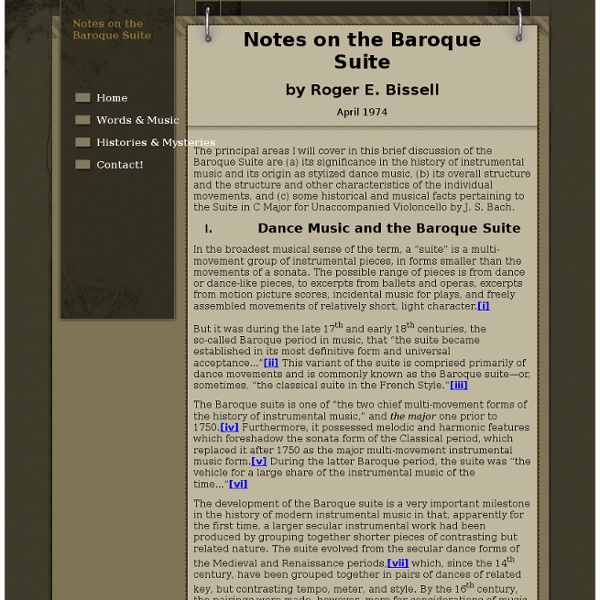Notes on the Baroque Suite

http://www.rogerbissell.com/id11b1.html
Baroque music
Baroque music forms a major portion of the "classical music" canon, being widely studied, performed, and listened to. Composers of the Baroque era include Johann Sebastian Bach, George Frideric Handel, Alessandro Scarlatti, Domenico Scarlatti, Antonio Vivaldi, Henry Purcell, Georg Philipp Telemann, Jean-Baptiste Lully, Arcangelo Corelli, Tomaso Albinoni, François Couperin, Denis Gaultier, Claudio Monteverdi, Heinrich Schütz, Jean-Philippe Rameau, Jan Dismas Zelenka, and Johann Pachelbel. The Baroque period saw the creation of tonality. During the period, composers and performers used more elaborate musical ornamentation, made changes in musical notation, and developed new instrumental playing techniques. Baroque music expanded the size, range, and complexity of instrumental performance, and also established opera, cantata, oratorio, concerto, and sonata as musical genres. Many musical terms and concepts from this era are still in use today.
The Dance Suite - The Baroque Suite, Suites
The suite is a type of instrumental dance music that emerged during the Renaissance and was further developed during the Baroque Period. It consists of several movements or short pieces in the same key and functions as dance music or dinner music during social gatherings. Dance music was very popular during the 16th and 17th century and composers were often asked to play such pieces during social functions. As a result, musicians began collecting dance pieces in the same key; these pieces became known collectively as "suites." By the time of JS Bach, suites were composed of four main movements: allemande, courante, sarabande and gigue. Optional movements include: air, bourree (lively dance), gavotte (moderately fast dance), minuet, polonaise, and prelude.
Related:
Related:



